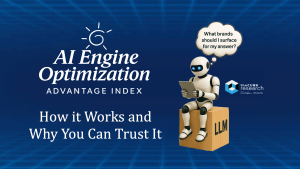AI literacy is a hot topic, and one I’m having many conversations about these days, both with industry peers and clients. That’s why a recent ebook from Grammarly, The New Language of Business: How an AI-Literate Workforce is the New Competitive Advantage, is worth a look.
The AI Literacy Gap
The data on AI literacy presented by Grammarly reveals a significant disparity in AI adoption between leaders and workers. While 89% of business leaders are at least familiar with gen AI, only 68% of workers have reached this level. This tracks with our research in this area and, while talk of AI and AI adoption is high, the reality is the adoption itself is not yet happening at quite the same pace as the talk might have us believe. And a big challenge there is AI literacy within organizations, or the lack thereof. This very real gap underscores the need for organizations to prioritize AI literacy across all levels of their workforce.
Obviously, it’s impossible to reap the myriad benefits that AI in general and generative AI in gen AI in particular can deliver if employees don’t understand how to use it. To that end, in Grammarly’s 2024 State of Business Communications report, data showed that most workers shared they don’t know how to use gen AI effectively. And that’s not necessarily because the learning curve is steep; sometimes it’s simply a matter of time and opportunity to explore and experiment that doesn’t exist in a normal workday. Here’s a look at Grammarly’s research data on AI literacy from a generational standpoint — nothing really surprising there.

AI experimentation is happening at a rapid pace, with Gen Z and Millennials exploring and adopting more quickly than their older counterparts. Again, not surprising. I’ll date myself here, but I vividly remember once having a boss who proudly proclaimed that email was stupid and that he’d never be caught dead using it. Chances are good that he is probably dead but, even then, I remember thinking how silly it was to look at what was, for that point in time, a huge advancement for society overall, especially from a communication standpoint, and to vow to never use it without ever really knowing what it was or how it would change the world. Gen AI is much the same — it is changing and will change the world.
This gap in AI literacy among genders does, however, clearly illustrate the need for AI literacy across stakeholder groups within organizations. Formal policies, guardrails, and regular and ongoing training is the smart path for businesses.
Also of interest, the data showing the AI literacy gap from a team standpoint was not surprising. Marketing, IT, and HR teams lead the way in AI literacy, with their counterparts in CX and Sales making headway. Organizations would do well to work to bring everyone up to speed and encourage adoption, helping speed innovation and realize some of the many benefits from a productivity, customer experience, and employee experience standpoint that AI can deliver.

It’s impossible to reap the myriad benefits that AI in general and generative AI in gen AI in particular can deliver if employees don’t understand how to use it. To that end, in Grammarly’s 2024 State of Business Communications report, data showed that most workers shared they don’t know how to use gen AI effectively. And that’s not necessarily because the learning curve is steep; sometimes it’s simply a matter of time and opportunity to explore and experiment that doesn’t exist in a normal workday.
The Human + Gen AI Future
Grammarly’s ebook on AI Literacy emphasizes that the future of business communication lies not in AI replacing humans, but in augmenting human capabilities. Gen AI serves multiple roles in this context:
- A thought partner for generating unique ideas
- A constructive critic for improving strategic value
- A time saver for handling repetitive tasks
- An innovation enabler for operationalizing ambitious concepts
The ebook wisely cautions against viewing AI as a replacement for human insight and creativity. Instead, it positions AI as a tool to enhance human capabilities, enabling knowledge workers to focus on more strategic and creative aspects of their roles.
Stages of Gen AI Adoption
One of the most valuable contributions of this ebook on AI literacy is its framework for understanding an organization’s progress in gen AI adoption. The five stages outlined are:
- Awareness stage
- Experimentation stage
- Optimization stage
- Standardization
- Transformation
This framework provides a clear roadmap for businesses to assess their current position and plan their journey toward full AI integration. It’s particularly noteworthy that many organizations are currently in the “Experimenting” phase, indicating significant room for growth and optimization, and plenty of time to get those AI literacy initiatives in motion.
Bridging the Adoption Gaps
Grammarly’s AI Literacy ebook identifies four key gaps that organizations must overcome to achieve enterprise-wide AI adoption:
The zero-to-one gap: Moving from awareness to experimentation
The literacy gap: Progressing from experimentation to optimization
The technology gap: Advancing from optimization to standardization
The systems gap: Transitioning from standardization to transformation
Each of these gaps represents a critical juncture where organizations must make strategic decisions and investments to move forward in their AI adoption journey.
A Roadmap for Enterprise-Wide Gen AI Adoption
Perhaps the most actionable part of the report is its five-step roadmap for achieving enterprise-wide gen AI literacy and adoption:
- Gain buy-in from leadership and employees
- Provide regular and ongoing training and education to improve AI literacy
- Invest in the right generative AI tools
- Create acceptable usage guidelines and policies
- Do the work: build an enterprise-wide gen AI culture
This roadmap offers a comprehensive approach to integrating gen AI into an organization’s DNA, addressing both technological and cultural aspects of the transformation.
Industry Implications of Embracing AI Literacy
The industry implications here of embracing AI literacy are many, and include:
Competitive Advantage. Organizations that prioritize AI literacy and adoption will likely outperform their peers in terms of productivity, innovation, and customer satisfaction.
Workforce Development. An AI-savvy workforce is a critical part of success for any organization wanting to leverage the benefits of AI and the AI skills gap is one of the biggest challenges organizations report. As such, it’s clear there is an urgent need for businesses to invest in AI literacy training and education for their employees at all levels.
Tool Selection. With the proliferation of AI tools, businesses must be discerning in their selection, prioritizing solutions that integrate seamlessly with existing workflows and offer robust security. A workforce steeped in AI literacy can help with this process, since they are the ones using the tools.
Ethical Considerations. As AI becomes more prevalent, organizations must develop clear guidelines and policies to ensure responsible and ethical use of the technology. A workforce comprised of AI-savvy folks is one of the keys to success on this front.
Cultural Shift. Successful AI adoption requires more than just technological implementation; it necessitates a cultural shift towards continuous learning and innovation, which goes hand in hand with AI literacy.
Conclusion
Grammarly’s New Language of Business: How an AI-Literate Workforce is the New Competitive Advantage ebook offers a compelling case for prioritizing AI literacy as a key competitive advantage. As businesses navigate the complexities of the AI revolution, those who invest in AI literacy programs, focus on upskilling their workforce, and strategically integrating gen AI into their operations will be best positioned to thrive in the evolving business landscape.
The journey toward enterprise-wide AI adoption is complex and multifaceted, but the potential rewards — in terms of enhanced productivity, innovation, and communication effectiveness — are substantial. As we move further into the AI era, the ability to leverage these technologies effectively will increasingly become a defining factor in business success and organizations that embrace AI literacy will be well-positioned to reap significant benefits.
Want to check out the ebook in its entirety? Find it here: The New Language of Business: How an AI-Literate Workforce is the New Competitive Advantage.
See more of my coverage here:
Grammarly’s New ROI Tools: A Game-Changer for AI Measurement in Enterprise Comms
Grammarly’s Enterprise Features Make Deploying Gen AI Secure, Easy, and a No-Brainer
Grammarly’s Strategic Suggestions Launch Signals the Company is Far More than an Editing Solution



